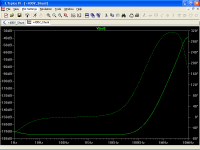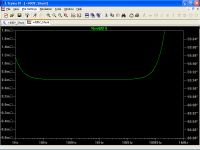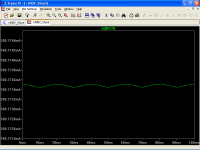Hi all
My 300B SE amplifier project is a bit delayed due to budget problems, so it advance slowly.
I want a hum free PSU, so I go for a shunt regulator. I use to use the aluminium chassis as heat sink, but more than 55 W dissipation seems a bit high and I did think on valve shunt elements.
At first I did think on DC filaments, but this will add about another 15 W dissipation, so against my principles I will try AC heaters.

I did simulate the AC heaters with a 6V3 AC voltage source via a 10 pF capacitor, incredibly, simulations do not show any trace of AC

Output impedance also looks as good as before

The only place one look a bit of AC is on M3 current

So, and please forgive my ignorance, can we say that M3 action takes care of the AC ripple on valve cathodes?
Addendum: Thermal drift of J2-R9 is still pending because BJT solution make curves ugly.
Thanks in advance.
My 300B SE amplifier project is a bit delayed due to budget problems, so it advance slowly.
I want a hum free PSU, so I go for a shunt regulator. I use to use the aluminium chassis as heat sink, but more than 55 W dissipation seems a bit high and I did think on valve shunt elements.
At first I did think on DC filaments, but this will add about another 15 W dissipation, so against my principles I will try AC heaters.

I did simulate the AC heaters with a 6V3 AC voltage source via a 10 pF capacitor, incredibly, simulations do not show any trace of AC

Output impedance also looks as good as before

The only place one look a bit of AC is on M3 current

So, and please forgive my ignorance, can we say that M3 action takes care of the AC ripple on valve cathodes?
Addendum: Thermal drift of J2-R9 is still pending because BJT solution make curves ugly.
Thanks in advance.
Last edited:
I think it's hilarious that you're going through the trouble of shunt regulating the high voltage supply but using AC heaters. The difference in noise between a CLC power supply and the shunt regulated power supply will be drowned out by your 5mV of hum.
55W isn't going to be cooked off easily by your chassis unless it's extremely thick or you put fans into it.
You might consider using a pentode as your top element and set it up as a CCS. An EL34 will tolerate a decent amount of heater cathode differential and you can move all that heat to the top side of the chassis.
I would also add that with simple CRC high voltage filtering, I've been able to get well under 1mV of noise out of a 300B SET. The keys to getting a quiet amp is heating the 300B with a DC supply and either having a choke filtered high voltage supply or a parallel feed output stage.
55W isn't going to be cooked off easily by your chassis unless it's extremely thick or you put fans into it.
You might consider using a pentode as your top element and set it up as a CCS. An EL34 will tolerate a decent amount of heater cathode differential and you can move all that heat to the top side of the chassis.
I would also add that with simple CRC high voltage filtering, I've been able to get well under 1mV of noise out of a 300B SET. The keys to getting a quiet amp is heating the 300B with a DC supply and either having a choke filtered high voltage supply or a parallel feed output stage.
xx431 and control circuit in the cathode of the EL34 and the whole thing under a simple ccs is one good way to do a shunt regulator. Lots of references on John Broskie's TubeCad site.
As for the filament. Bottlehead's Paul Joppa had an interesting way of doing the ac heating for a 300B using a rectifier into bifilar wound dual bay choke. You might try contacting him or Bottlehead for details. They used to sell the chokes for personal (ie. non-Bottlehead kit) use.
As for the filament. Bottlehead's Paul Joppa had an interesting way of doing the ac heating for a 300B using a rectifier into bifilar wound dual bay choke. You might try contacting him or Bottlehead for details. They used to sell the chokes for personal (ie. non-Bottlehead kit) use.
I think it's hilarious that you're going through the trouble of shunt regulating the high voltage supply but using AC heaters. The difference in noise between a CLC power supply and the shunt regulated power supply will be drowned out by your 5mV of hum.
55W isn't going to be cooked off easily by your chassis unless it's extremely thick or you put fans into it.
You might consider using a pentode as your top element and set it up as a CCS. An EL34 will tolerate a decent amount of heater cathode differential and you can move all that heat to the top side of the chassis.
I would also add that with simple CRC high voltage filtering, I've been able to get well under 1mV of noise out of a 300B SET. The keys to getting a quiet amp is heating the 300B with a DC supply and either having a choke filtered high voltage supply or a parallel feed output stage.
Hi, thanks for your input.
In a series regulator, or a raw PSU the loop pass through rectifiers and capacitors, in a shunt regulator currents are delocalized, that's another reason to make this, regardless how hilarious seem to you.
xx431 and control circuit in the cathode of the EL34 and the whole thing under a simple ccs is one good way to do a shunt regulator. Lots of references on John Broskie's TubeCad site.
As for the filament. Bottlehead's Paul Joppa had an interesting way of doing the ac heating for a 300B using a rectifier into bifilar wound dual bay choke. You might try contacting him or Bottlehead for details. They used to sell the chokes for personal (ie. non-Bottlehead kit) use.
Hi, thanks for your input.
XX431 are very noisy, take a look at its datasheet.
My question is about feeding the heaters of shunt valves (EL34) with AC, not the 300B, for that the best of the best are Rod Coleman's regulators. I do not want intermodulation.
Last edited:
Just for clarification, I will use DC heaters in the 300B amplifier, regulators are already designed, not all by me BTW.
AC is ONLY for the shunt valves (EL34) if and only if someone can answer my original question about the presense of AC on the cathodes and not on the output as simulations suggest.
My apologies for misspoken Tarzan-English. 😀
AC is ONLY for the shunt valves (EL34) if and only if someone can answer my original question about the presense of AC on the cathodes and not on the output as simulations suggest.
My apologies for misspoken Tarzan-English. 😀
Last edited:
I think he is suggesting the shunt tubes should have DC filament supplies, I don't necessarily agree, but you need to make sure no AC gets through to the regulated DC from the filaments, and that in my experience is not as trivial as it sounds. (I am abandoning tube regulators in some of my phono stage designs because of AC filament related problems)
I can get below a couple mVpp with a CLCLC filter, but obviously even with multiple parallel film caps in the last stage will not have the low source impedance of the shunt regulator.
As an aside I do use AC heating in the series pass EL34 based regulators of my line stage, and wide band noise on the output is under 2mVpk on a 380V output - not too bad for a simple regulator circuit.
I can get below a couple mVpp with a CLCLC filter, but obviously even with multiple parallel film caps in the last stage will not have the low source impedance of the shunt regulator.
As an aside I do use AC heating in the series pass EL34 based regulators of my line stage, and wide band noise on the output is under 2mVpk on a 380V output - not too bad for a simple regulator circuit.
I think he is suggesting the shunt tubes should have DC filament supplies, I don't necessarily agree, but you need to make sure no AC gets through to the regulated DC from the filaments, and that in my experience is not as trivial as it sounds. (I am abandoning tube regulators in some of my phono stage designs because of AC filament related problems)
I can agree that it is really hilarious to use a shunt regulator on the PSU and AC heaters on the amp.
He also suggest to feed the 300B heaters with a DC supply, which probes that my Tarzan-English worsens with time.
I also agree with you that it is not a trivial issue if feeding EL34 heaters with AC, that AC does not appears on the output, unless simulation suggest that it doesn't.
I can get below a couple mVpp with a CLCLC filter, but obviously even with multiple parallel film caps in the last stage will not have the low source impedance of the shunt regulator.
I hate transformers, chokes and all anisotropic non-linear and hence hysteresis devices, I will wind the last transformers and after that I will burn the lathe. 😀
As an aside I do use AC heating in the series pass EL34 based regulators of my line stage, and wide band noise on the output is under 2mVpk on a 380V output - not too bad for a simple regulator circuit.
That sounds consistent, in a series pass element AC cancellation seems a bit more difficult.
Last edited:
Yes, sorry, I was speed reading and thought you were talking about the 300B filaments. Rod's boards are great, no arguement there.
As for the 431, I have a bag of LX6431 to use up and have found them very useful. People keep saying how noisy they are but personally I haven't heard it, so until the bag is empty . . . . .
As for the 431, I have a bag of LX6431 to use up and have found them very useful. People keep saying how noisy they are but personally I haven't heard it, so until the bag is empty . . . . .

today, 470ufd/450 volt caps are dirt cheap, i bought a box containing a hundred of these made in thailand caps, brand new...
so instead of shunt regs, i can reduce psu ripples to very low values using ecaps in conjunction with my filter chokes..
Patrick Turner explained in detail about tube psu...powersupplies
FWIW, i built 2 2A3 sets, i installed a humdinger pots to null out the hum,
lo and behold, the owner adjusted the pot for a little bit of hum and he claimed that the sound become more dynamic and open, who am i to doubt him?
so instead of shunt regs, i can reduce psu ripples to very low values using ecaps in conjunction with my filter chokes..
Patrick Turner explained in detail about tube psu...powersupplies
FWIW, i built 2 2A3 sets, i installed a humdinger pots to null out the hum,
lo and behold, the owner adjusted the pot for a little bit of hum and he claimed that the sound become more dynamic and open, who am i to doubt him?
Yes, sorry, I was speed reading and thought you were talking about the 300B filaments. Rod's boards are great, no arguement there.
As for the 431, I have a bag of LX6431 to use up and have found them very useful. People keep saying how noisy they are but personally I haven't heard it, so until the bag is empty . . . . .
Nothing to worry about, on post #5 I realized that my Tarzan-English instead of clarifying, really confuses people.
As for the 431 seems to me that they have no place in a low noise shunt regulator, I will use the LM329 as a voltage reference, even so an RC filter is paramount.
today, 470ufd/450 volt caps are dirt cheap, i bought a box containing a hundred of these made in thailand caps, brand new...
so instead of shunt regs, i can reduce psu ripples to very low values using ecaps in conjunction with my filter chokes..
Patrick Turner explained in detail about tube psu...powersupplies
FWIW, i built 2 2A3 sets, i installed a humdinger pots to null out the hum,
lo and behold, the owner adjusted the pot for a little bit of hum and he claimed that the sound become more dynamic and open, who am i to doubt him?
As I said before, in a series or raw supply, the loop reaches the rectifiers and the capacitors, this is not good for a SE amp.
As for amp valve heaters there are enough evidence of mains frequency intermodulation from the AC heaters, which you sistematicaly denies in every thread on the subject.
Some low hum valves uses helical heaters to reduce the magnetic field, even so it is not enough for certain applications.
Mind you that we are in the 21th century, better solutions came out, I think that it is called technological progress. 😉
Ah good, you're going to DC heat the 300Bs.
The TL431 is plenty quiet for what you're up to, but since you believe it not to be, what is your goal for the noise floor of the amplifier? At some point the tubes themselves will produce some noise and you won't get rid of that with a HV regulator.
The TL431 is plenty quiet for what you're up to, but since you believe it not to be, what is your goal for the noise floor of the amplifier? At some point the tubes themselves will produce some noise and you won't get rid of that with a HV regulator.
Yes. I will DC heat the 300B and all other valves, except perhaps the EL34 on the shunt regulator.Ah good, you're going to DC heat the 300Bs.
I do not agree.The TL431 is plenty quiet for what you're up to, but since you believe it not to be, what is your goal for the noise floor of the amplifier? At some point the tubes themselves will produce some noise and you won't get rid of that with a HV regulator.
http://www.ti.com/lit/ds/symlink/tl432a.pdf
TL431 is noisy, see figure 7 and 8 on page 15. It is not completely stable, see figure 16 on page 16.
TL431 is in itself a shunt regulator, see figure 26 on page 19, hence the shunt action cannot take care of noise which is at least ten times higher than the noise of a cheap LED.
I am concerned about the noise floor of the entire system, it can be maintained reasonably low
i) Choosing low noise valves
ii) Putting the volume pot after the gain stage and before the output buffer in the preamp.
iii) Choosing relevant resistor values as low as possible and the correct ones according to application/position (Metal-film, wire-wound,..., etc.)
iv) Avoiding the use of a volume pot at amplifier input.
v) Using a PSU as quiet as possible.
vi) Winding all the transformers so that their external magnetic field will be as low as possible, and potting them into ferromagnetic cans, such as annealing iron.
vii) Careful wiring.
These are nanovolts!!!!! of noise. The self noise of the 300B is going to be 60+ dB higher than this.TL431 is noisy, see figure 7 and 8 on page 15.
A very, very small RC snubber across your HV will take care of this. Something like 0.22uF in series with 100R carbon comp should do the job.It is not completely stable, see figure 16 on page 16.
iv) Avoiding the use of a volume pot at amplifier input.

Hi, thanks for your input.
Making some calculations, a long ago, I found that the noise of my beloved 100K Alps Black Beauty is of the same order of magnitude than the noise of the pre amp, as power amps have in general more gain, the worse place for the volume pot is there.
The moral was: Put the volume pot on the place that it causes the less damage as possible.
I still envy your Siemens trafo

These are nanovolts!!!!! of noise.
No, these are nV/√Hz, Integrating you obtain about 8 μVp-p (figure 8, page 15) which is about ten times the noise of a cheap LED as I said before.
The self noise of the 300B is going to be 60+ dB higher than this.
I do not think so, but if you have measurements please post them.
As transconductance of the 300B is not that low, is likely a medium-low noise valve.
I like your plan because it's logical.
Volume pot on input of amp is a pretty bad choice. And it is not necessary, at all.
My DAC output has a volume pot -> buffer. And tuner (for local FM stations) has remote control.
Btw, do not forget elevate Uf-f for input/driver tube.
Best DIYing
Volume pot on input of amp is a pretty bad choice. And it is not necessary, at all.
My DAC output has a volume pot -> buffer. And tuner (for local FM stations) has remote control.
Btw, do not forget elevate Uf-f for input/driver tube.
Best DIYing
- Status
- Not open for further replies.
- Home
- Amplifiers
- Tubes / Valves
- Shunt regulator for 300B amp - Advice needed